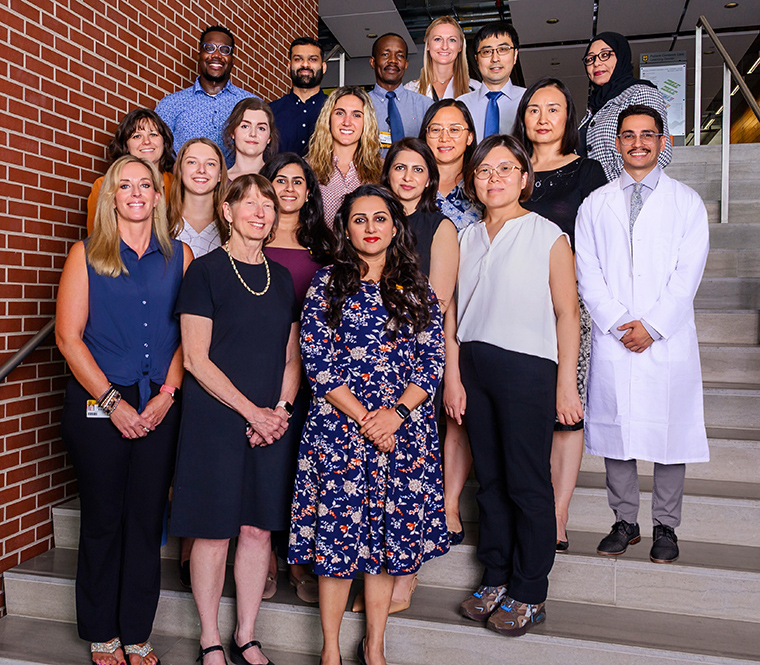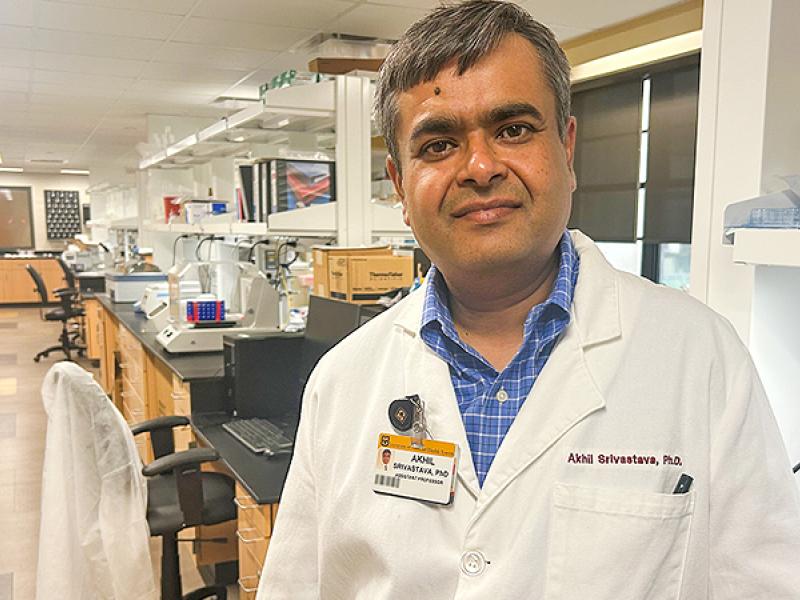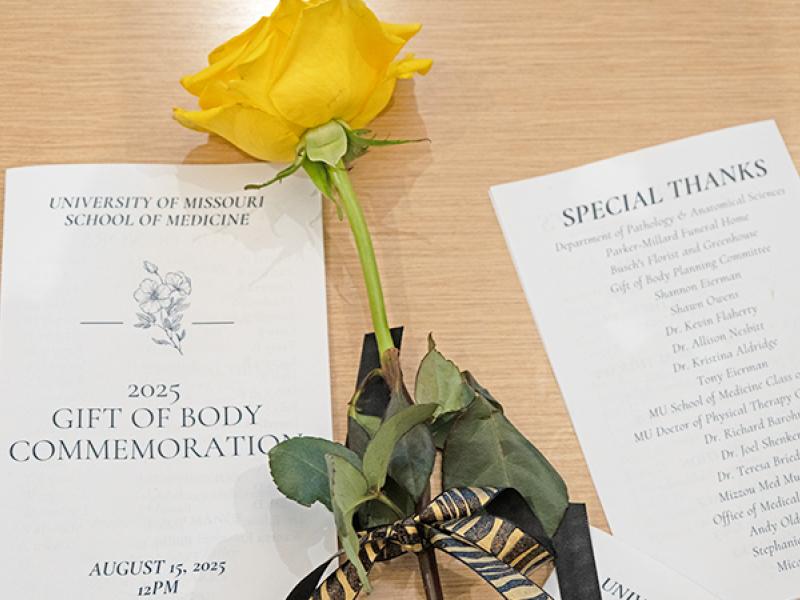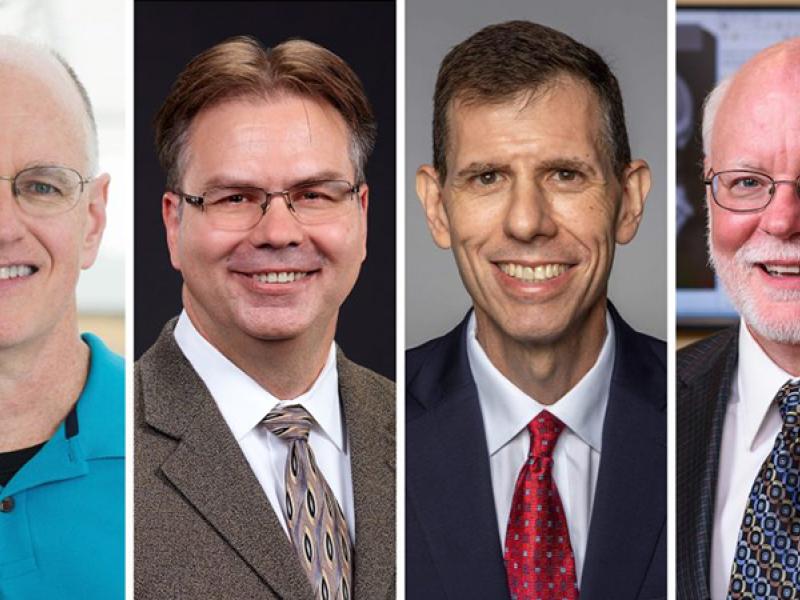Our ACGME-accredited program is dedicated to the thorough education and training of future pathologists, whether their career paths go into academic pathology, community practice, or industry. The program has tracks for traditional four-year integrated training in both anatomic (AP) and clinical pathology (CP), and for three-year AP-only or CP-only training. On occasion by special arrangement, residents who began training elsewhere may be accepted at advanced standing for AP, CP, or for a combined program.

AP includes experience in autopsy and surgical pathology (including subspecialties of pediatric pathology, gastrointestinal pathology, gynecologic pathology, neuropathology, hematopathology, and dermatopathology), forensic pathology, exfoliative and aspiration cytology, and renal pathology. Immunohistochemistry is routinely used and diagnostic electron microscopy is available as necessary.
CP includes experience in hematology (including hematopathology crossing lines with anatomic pathology), coagulation, blood bank and transfusion medicine, flow cytometry, immunopathology, clinical chemistry, microbiology and cytogenetics, toxicology and transplantation (HLA) immunology. All residents receive instruction in laboratory management and in pathology informatics.
The Anatomic and Clinical Pathology Residency Program of the Department of Pathology and Anatomical Sciences at the University of Missouri has a considerable history, and our residents and graduates do well. The pass rate for first-time takers of American Board of Pathology examinations during the past five years is 100% for Clinical Pathology examinations and 100% for Anatomic Pathology examinations. Our residents secure fellowships in their chosen subspecialties at prestigious major institutions.
For surgical pathology, residents experience a partially sub-specialized and partially general sign-out environment: we have subspecialty sign-out for GI and liver biopsies, for neuropathology, for ophthalmological pathology and for hematopathology. All other areas are in general sign-out, although particular members of the faculty are experts in, and are often responsible for sign-out of, bone and soft tissue pathology cases and gynecological pathology cases. Most of the dermatological pathology cases belong to the dermatopathology service in the Department of Dermatology, but the dermatopathologist participates in teaching pathology residents both through rotations on that service and through sign-out and didactic sessions in pathology space.
Cytopathology rotations include performance of, or immediate review for adequacy, of many fine needle aspiration biopsies. Our autopsy rotations include time in the office of the chief medical examiner as well as performing hospital autopsies to qualify to take the AP examination of the American Board of Pathology.
Blood Bank/Transfusion Medicine rotations involve residents in daily patient care, through interactions with clinicians of patients who may need blood products or who may have had an adverse reaction from a blood product. Apheresis procedures are part of a resident’s exposure while in blood banking, depending on when they occur.
We have residents in University Hospital, the Harry S. Truman Memorial Veterans' Hospital, and our Birthing Center. Pathology residents have two required outside rotations at Children's Mercy Hospital in Kansas City, Missouri for both pediatric surgical pathology and also cytogenetics. Both of these rotations are one-month long. We work hard to keep elective time in each resident’s schedule during the four years.
Molecular genetic pathology testing is applied to a broad range of areas of pathological diagnosis, from surgical pathology and cytopathology through hematology/hematopathology, microbiology, and transfusion medicine. Residents are trained in the ordering and interpretation of molecular genetic pathology testing in each area as it is appropriate to that area.
All house staff actively participate in teaching medical students. Research and other teaching opportunities are available and encouraged.
Tracks
Most residents follow a four-year, Anatomic Pathology and Clinical Pathology track, culminating in eligibility for board certification in both AP and CP. A few residents opt for three-year AP-only or, very rarely, CP-only tracks leading to eligibility for only one of those certifications.
Locations
All training programs are under the sponsorship and direction of the University of Missouri School of Medicine. University facilities include the 632-bed University Hospital, Birthing Center, the Ellis Fischel Cancer Center, outpatient clinics, Medical Sciences Building of the School of Medicine, the Diabetes and Eye Research Centers, and the Health South Rehabilitation Center. Residents also rotate to Children's Mercy Hospital in Kansas City for pediatric surgical pathology, as well as cytogenetics and molecular genetic pathology. The closely affiliated 104-bed Harry S. Truman Memorial Veterans Hospital is across the street, and there are regular rotations to or other tasks at this affiliated VA hospital. Our blood bank, coagulation and HLA laboratories are coordinated with the American Red Cross Laboratories located one-half mile from the University Medical Center and all clinical services provided by these laboratories are directed by faculty of this department.
Specimen volumes (yearly approximations) are: surgical pathology well over 20,000, clinical pathology 1,100,000, cytology 17,000 including an active fine needle aspiration service, bone marrows 245, and hospital autopsies 60. Over 600 Medical Examiner’s cases are also used for resident training. The Medical Examiner’s facility is located in the University medical center complex and is an integral part of the Department; the MEs are full-time faculty. Research facilities include various core laboratories within the department, and University-wide core laboratories. Excellent, cross-referred photographic files, paraffin tissue blocks, and glass slide collections include specimens since the 1970’s, and are in addition to digital photographic collections.
Conferences
Residents have didactic conferences daily, Monday through Friday, from 8 a.m. to 9 a.m.; this is protected time. There are additional didactic sessions specific to clinical pathology rotations as a group.
- Hematology/hematopathology didactic session with a senior clinical hematologist/oncologist as well as pathology faculty are held once per week from 9 a.m. to 9:30 a.m.
- A weekly dermatopathology conference at a multi-head microscope with a dermatopathologist, usually starting at 1:30 p.m. and lasting as long as necessary into the afternoon.
- A brain cutting conference is also held weekly for the autopsy service, starting at 9:15 a.m. and lasting as long as necessary to finish the week’s cases.
Additionally, residents present at, and participate in, multiple conferences for clinical services. These include:
- multidisciplinary oncology conferences (weekly; one per month is neuro-oncology),
- nephrology conference,
- breast conference,
- pulmonary medicine conference,
- infectious disease rounds,
- Transfusion Committee,
- and hematology/hematopathology rounds, among others.
How to Apply
- Candidates should be graduates of approved schools of medicine in the U.S. or Canada or of approved foreign medical schools.
- International medical graduates must have passed USMLE Steps I, IICK, and IICS, must be ECFMG certified, must be eligible for Missouri medical licensure. and must either be U.S. citizens, U.S. permanent residents or hold an appropriate visa to work as resident physicians.
- Satisfactory references are required.
- Applicants will find it advisable to be able to demonstrate some experience in pathology (elective rotations in medical school, “observerships” or “externships”, prior residency training in another country) although this is not strictly required.
- Normal starting date is July 1. Applications must be submitted electronically through ERAS, preferably soon after it opens up each September.






